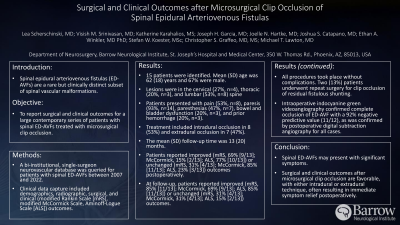Surgical and Clinical Outcomes after Microsurgical Clip Occlusion of Spinal Epidural Arteriovenous Fistulas
Surgical and Clinical Outcomes After Microsurgical Clip Occlusion of Spinal Epidural Arteriovenous Fistulas
Friday, April 21, 2023

.jpg)
Lea Scherschinski, MD
Postdoctoral Research Fellow
Barrow Neurological Institute
Phoenix, Arizona, United States
ePoster Presenter(s)
Introduction: Spinal epidural arteriovenous fistulas (ED-AVFs) are a rare but clinically distinct subset of spinal vascular malformations. The aim of this study was to report surgical and clinical outcomes for a large contemporary series of patients with spinal ED-AVFs treated with microsurgical clip occlusion.
Methods: A bi-institutional, single-surgeon neurovascular database was queried for patients with spinal ED-AVFs between 2007 and 2022. Clinical data capture included demographics, radiographic, surgical, and clinical (modified Rankin Scale [mRS], modified McCormick Scale, Aminoff-Logue Scale [ALS]) outcomes.
Results: Fifteen patients were identified. The mean (SD) age was 62 (18) years and 67% were male. Lesions were located in the cervical (27%, n=4), thoracic (20%, n=3), and lumbar (53%, n=8) spine. Patients presented with pain (53%, n=8), paresis (93%, n=14), paresthesias (47%, n=7), bowel and bladder dysfunction (20%, n=3), and prior hemorrhage (20%, n=3). Nine (60%) lesions were previously embolized. Treatment included intradural occlusion in 8 (53%) and extradural occlusion in 7 (47%). The mean (SD) follow-up time was 13 (20) months. Patients reported improved (mRS, 69% [9/13]; McCormick, 15% [2/13]; ALS, 77% [10/13]) or unchanged (mRS, 31% [4/13]; McCormick, 85% [11/13]; ALS, 23% [3/13]) outcomes postoperatively. At follow-up, patients reported improved (mRS, 85% [11/13]; McCormick, 69% [9/13]; ALS, 85% [11/13]) or unchanged (mRS, 31% [4/13]; McCormick, 31% [4/13]; ALS, 15% [2/13]) outcomes. All procedures took place without complications. Two (13%) patients underwent repeat surgery for clip occlusion of residual fistulous shunting. Intraoperative indocyanine green videoangiography confirmed complete occlusion of ED-AVF with a 92% negative predictive value (11/12), as was confirmed by postoperative digital subtraction angiography for all cases.
Conclusion : Spinal ED-AVFs may present with significant symptoms. Surgical and clinical outcomes after microsurgical clip occlusion are favorable, with either intradural or extradural technique, often resulting in immediate symptom relief postoperatively.
Methods: A bi-institutional, single-surgeon neurovascular database was queried for patients with spinal ED-AVFs between 2007 and 2022. Clinical data capture included demographics, radiographic, surgical, and clinical (modified Rankin Scale [mRS], modified McCormick Scale, Aminoff-Logue Scale [ALS]) outcomes.
Results: Fifteen patients were identified. The mean (SD) age was 62 (18) years and 67% were male. Lesions were located in the cervical (27%, n=4), thoracic (20%, n=3), and lumbar (53%, n=8) spine. Patients presented with pain (53%, n=8), paresis (93%, n=14), paresthesias (47%, n=7), bowel and bladder dysfunction (20%, n=3), and prior hemorrhage (20%, n=3). Nine (60%) lesions were previously embolized. Treatment included intradural occlusion in 8 (53%) and extradural occlusion in 7 (47%). The mean (SD) follow-up time was 13 (20) months. Patients reported improved (mRS, 69% [9/13]; McCormick, 15% [2/13]; ALS, 77% [10/13]) or unchanged (mRS, 31% [4/13]; McCormick, 85% [11/13]; ALS, 23% [3/13]) outcomes postoperatively. At follow-up, patients reported improved (mRS, 85% [11/13]; McCormick, 69% [9/13]; ALS, 85% [11/13]) or unchanged (mRS, 31% [4/13]; McCormick, 31% [4/13]; ALS, 15% [2/13]) outcomes. All procedures took place without complications. Two (13%) patients underwent repeat surgery for clip occlusion of residual fistulous shunting. Intraoperative indocyanine green videoangiography confirmed complete occlusion of ED-AVF with a 92% negative predictive value (11/12), as was confirmed by postoperative digital subtraction angiography for all cases.
Conclusion : Spinal ED-AVFs may present with significant symptoms. Surgical and clinical outcomes after microsurgical clip occlusion are favorable, with either intradural or extradural technique, often resulting in immediate symptom relief postoperatively.
